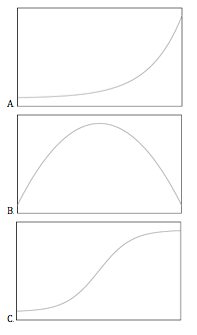Lesson 1 Activity 1 - Papercatchers
In this activity, students will learn about population growth and limits to growth. Students will play the part of members of a growing population and experience limits to the growth of populations when resources are limited. Students will analyze different patterns of population growth including exponential and logistic growth and will learn the ecosystem concept of carrying capacity.
Review complex adaptive systems concepts as they relate to ecosystems: [read the document Ecosystems as Complex Adaptive Systems]
Quiz questions:
Consider the following population growth patterns shown in the plots (where the y-axis is population size and the x-axis is time).

Reflection:
Reflect on the correspondence between the model of Papercatchers and patterns of growth in real-world ecosystems.
- Watch a video of students playing the game "Papercatchers"
- Review complex adaptive systems concepts as they relate to ecosystems
- Review connections to computer modeling and simulation
Review complex adaptive systems concepts as they relate to ecosystems: [read the document Ecosystems as Complex Adaptive Systems]
- One of the characteristics of a complex system is that the behavior of some aspect of the system, seen as a whole, doesn't necessarily follow directly from an understanding of how the individual “parts” of the system work. In other words, “the sum of the parts is greater than the whole.”
- Another characteristic of most complex adaptive systems is feedback. Feedback is a circular process in which a system's output is returned or “fed back” into the system as input. For example, if we look at the ecosystem of fish in a pond, where the fish are not being consumed by predators we see that as the population approaches the carrying capacity of the pond, the rate of population growth decreases. This happens via limits in required resources (e.g. oxygen in the water). So the increase in the fish population leads to a reduction in the necessary resources available to each member of the population, which in turn leads to moderation in the rate of increase in the population. We will see this type of pattern in the participatory simulation and models that accompany this module. (This type of feedback is called negative, or damping feedback.)
- Possibly most important, ecosystems often demonstrate emergent behavior. This is related to the first point, where the overall behavior turns out not to be obvious from the component behavior. In a high desert ecosystem, simply knowing that rabbits eat grass, coyotes eat rabbits, and mountain lions eat rabbits and coyotes, doesn't tell us much (beyond giving us a general sense) about the patterns in the respective populations over time – we really need to study the ecosystem as a whole. From the above, we can see that ecosystems are usually complex adaptive systems, as well.
- Is "Papercatchers" a model?
- Could we model the Papercatchers on the computer? If so, how?
- Who would be the agents, environment, interactions?
Quiz questions:
1 point
Which of the following is NOT a characteristic of complex adaptive systems as seen in ecosystems?
Consider the following population growth patterns shown in the plots (where the y-axis is population size and the x-axis is time).

1 point
Which population growth pattern would you expect to see when there was no resource limitation?
1 point
Which population growth pattern would you expect to see when there was a resource limitation?
Reflection:
Reflect on the correspondence between the model of Papercatchers and patterns of growth in real-world ecosystems.
- What characteristics of complex adaptive systems can be seen in an ecosystem?
- What is an ecosystem in your community that you could model for your final project?
